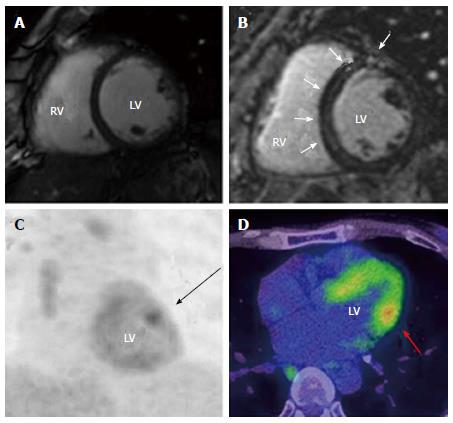Copyright
©2014 Baishideng Publishing Group Inc.
World J Cardiol. Jul 26, 2014; 6(7): 585-601
Published online Jul 26, 2014. doi: 10.4330/wjc.v6.i7.585
Published online Jul 26, 2014. doi: 10.4330/wjc.v6.i7.585
Figure 5 Representative short axis cine- cardiac magnetic resonance (A), late gadolinium enhancement-cardiac magnetic resonance (B), 18F-fluorodeoxyglucose-positron emission computed tomography (C), and positron emission computed tomography (D) images in a 57-year-old male patient with systemic sarcoidosis.
The diagnosis of sarcoidosis was made with liver biopsy. Cine-CMR images shows normal LV size and contraction (LVEDV: 119 mL, LVEF: 73%), but LGE-CMR reveals patchy and striated LGE in anterior wall and inter-ventricular septum (white arrows). The patient was negative for cardiac involvement of sarcoidosis according to the guideline of Japanese Ministry of Health and Welfare. However, FDG-PET and PET-CT images demonstrate hot spot in postero-lateral wall of LV, indicative of active inflammatory change (black and red arrows). FDG-PET: 18F-fluorodeoxyglucose-positron emission computed tomography; LGE: Late gadolinium enhancement; LV: Left ventricular; LGE-CMR: Late gadolinium enhancement-cardiac magnetic resonance.
- Citation: Satoh H, Sano M, Suwa K, Saitoh T, Nobuhara M, Saotome M, Urushida T, Katoh H, Hayashi H. Distribution of late gadolinium enhancement in various types of cardiomyopathies: Significance in differential diagnosis, clinical features and prognosis. World J Cardiol 2014; 6(7): 585-601
- URL: https://www.wjgnet.com/1949-8462/full/v6/i7/585.htm
- DOI: https://dx.doi.org/10.4330/wjc.v6.i7.585









